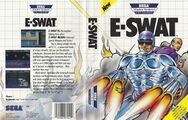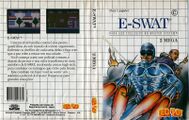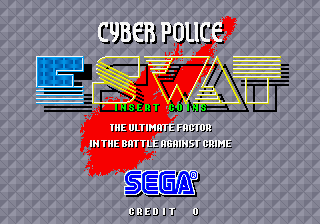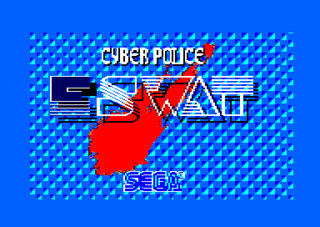- For the Sega Mega Drive release of Cyber Police ESWAT, see ESWAT: City Under Siege.
Cyber Police ESWAT (サイバーポリス イースワット) is a side-scrolling shooter game developed by Sega R&D 1 for the Sega System 16 arcade board in 1989.
Story
Cyber Police ESWAT sees the player as Duke Oda, a Japanese-American police officer accepted into the crime-ridden Liberty City Police Department's top unit, E.S.W.A.T. (Enhanced Special Weapons and Tactics). Duke starts off as a regular human being, but during the course of the game is given a powered exoskeleton (called I.C.E. in the attract sequence, which stands for "Individual Combat Equipment") to fight against a powerful high-tech crime organisation named "E.Y.E." which is threatening the city. His ultimate goal is to apprehend "Balzar" a mad scientist, when E.Y.E is revealed to be a rogue artificial intelligence computer.
Gameplay
ESWAT is a run-and-gun game in which the player must eliminate threats approaching from either side of the screen. After completing a few missions, player is accepted to the elite E.S.W.A.T. unit and given a power suit and special weapons. Each stage is divided to several levels, and a boss is waiting at the end of each stage.
Power-Ups
- Bullets: Increase the number of bullets player has.
- Plasma Cannon: Powerful energy weapon that penetrates through enemies in a straight line.
- Multi-Shot: Opens fire to all targets in front of the player in a 90 degrees angle.
- Heat Charges: Launches two powerful bombs that travel around the screen. Strongest weapon in the game.
Stages (Arcade Version)
|
|
Stage 1: Bank Robbery
|
| Boss: Fatman. He covers himself with a shield to block pistol shots. He will be vulnerable when he lowers his shield to breath a fire ball. Also occasionally rolls on the ground.
|
|
|
Stage 2: Hostage Situation
|
| Boss: Nasty Nick. He uses the hostage as a shield and throws a hard to evade boomerang. Jump up and fire towards his face to damage him. Shooting the hostage does not penalize the player other than giving an ear-piercing shriek. Kicking him will knock Nick down instantly.
|
|
|
Stage 3: Truck Stop
|
| Boss: The Captain. He will swing his anchor towards you like a flail. He can either swing while standing or crouching. He is vulnerable when he throws the anchor towards you. Completing this level will allow player to joing ESWAT unit and wear the power suit.
|
|
|
Stage 4: Rooftops
|
| Boss: Dirty Duffy. He will attack you with his own power armor. Keep the distance from him and fire your arm mounted gatling gun away. He will occasionally jump over you to the other side of the screen.
|
|
|
Stage 5: Derelict Building
|
| Boss: Flamethrower Guy. You will be attacked by multiple enemies and a guy with a flamethrower. He can rapidly reduce your health so, keep distance and fire away.
|
|
|
Stage 6: Condemned Block
|
| Boss: Collapsing Building. Once you enter, Duffy will remotely activate explosives while the building you are in will slowly start to collapse. Stay clear from explosives as they detonate. Once you are out, Duffy will shoot his pistol towards you. A single shot will be enough to make him surrender.
|
|
|
Stage 7: China Town
|
| Boss: Tiger. A tiger will charge towards you. Watch its movements carefully and jump when it is charging and duck when it is jumping over you.
|
|
|
Stage 8: Warehouse
|
| Boss: Gorilla. It will either throw wooden barrels or get close and smash you with its fists. As usual, keep distance and fire away. If it is moving towards you, quickly move forwards and backwards to prevent it from cornering you.
|
|
|
Stage 9: Rooftops
|
| Boss: Monster Truck. Rats Lee will be driving his oversized pick-up. His thugs at the back will throw grenades towards you. If the truck moves all the way backwards, move to the other edge of the screen as he will try to run over you.
|
|
|
Stage 10: Dockyard
|
| Boss: Laser Turrets. A group of laser turrets will move upwards and downwards and fire their lasers. There is a considerable delay between firings so use this momentum to move around and avoid fire.
|
|
|
Stage 11: Harbor
|
| Boss: Personal Flight Platforms. Two men with hovering bikes will fly around and attack you with lasers. They are quite fast so time your shots carefully and always move around to avoid projectiles.
|
|
|
Stage 12: Factory
|
| Boss: Black Devils. Two robots equipped with the same ICE armor player is wearing will attack at the same time. They can jump around and crouch, making them much harder targets than usual.
|
|
|
Stage 13: Secret Entrance
|
| Boss: Incinerator. A moving platform will drop molten iron lumps to the conveyor player is standing. Keep moving right to not to fall to the pitfall on the left and jump over the burning trash. Fire upwards whenever platform is nearby.
|
|
|
Stage 14: Armory
|
| Boss: Mini-Tank. Rockets can be evaded by crouching while gun at the top will only hit you if you jump. Mortar at the back will be a problem however and you must watch avoid it by staying close to the tank or jumping backwards or forwards when it is just about to hit the ground.
|
|
|
Stage 15: Balzar's Throne Room
|
| Balzar's throne will be surrounded by four tesla-coil like weapons. Keep moving around and fire towards each coil until they are destroyed. Heat Charges can bring them down very quickly if you have them.
|
History
Legacy
Cyber Police ESWAT's moderate success saw it ported to multiple platforms. Sega brought it to the Sega Master System in 1990, and U.S. Gold were given the license to publish versions for home computers, including the Amiga, Amstrad CPC, Atari ST, Commodore 64 and ZX Spectrum.
A "sequel" or "remake" in the form of ESWAT: City Under Siege was released for the Sega Mega Drive in 1990. Cyber Police ESWAT and ESWAT: City Under Siege are frequently mistaken to be the same game, but although both share a similar gameplay style, the Mega Drive game is very different.
Production credits
System 16 version
While hard to see, a high score table is displayed during the game's attract mode in-between lots of information about the ESWAT suit.
Source: In-game high score table
In addition, the "Information On Under" details for the suit hide more of Hisaki Nimiya's name.
- SA-KI4908
- NMY-NS250R
- IIA-ZX400
Master System version
Magazine articles
- Main article: Cyber Police ESWAT/Magazine articles.
Promotional material
- Main article: Cyber Police ESWAT/Promotional material.
Artwork
Physical scans
System 16 version
| {{{{{icon}}}|L}}
|
Division by zero.
|
Based on
0 review
|
| Sega Retro Average
|
| Publication
|
Version
|
Score
|
|
| (UK)
|
|
|
[16]
|
| (UK)
|
|
|
[17]
|
|
| System 16, US
|
|
|
 Manual |
| System 16, JP
|
|
|
  Instuction card(s) |
Master System version
| Sega Retro Average
|
| Publication
|
Score
|
Source
|
| (ES)
|
50
|
[18]
|
|
| Master System, US
|
 Cover
|
 Manual |
| Master System, EU
|
 Cover
|
 Manual |
| Master System, BX†
|
 Cover
|
|
|
| Master System, AU
|
 Cover
|
 Cart |
| Master System, BR (cardboard)
|
 Cover
|
 Cart  Manual |
| Master System, BR
|
 Cover
|
 Cart |
Mega-Tech version
Amiga version
| {{{{{icon}}}|L}}
|
Division by zero.
|
Based on
0 review
|
| Amiga, UK
|
|
|
 Disk 1 |
Amstrad CPC version
| {{{{{icon}}}|L}}
|
Division by zero.
|
Based on
0 review
|
| Amstrad CPC, UK (cassette)
|
|
|
 Cassette |
| Amstrad CPC, ES (cassette)
|
|
|
 Cassette |
| Amstrad CPC, ES (disk)
|
|
|
 Disk |
| Amstrad CPC, ES (Especial 8 Bits)
|
|
|
|
|
Atari ST version
| {{{{{icon}}}|L}}
|
Division by zero.
|
Based on
0 review
|
Commodore 64 version
| {{{{{icon}}}|L}}
|
Division by zero.
|
Based on
0 review
|
| Commodore 64, UK (cassette)
|
 Cover
|
|
|
ZX Spectrum version
| {{{{{icon}}}|L}}
|
Division by zero.
|
Based on
0 review
|
| Sega Retro Average
|
| Publication
|
Version
|
Score
|
|
| (UK)
|
|
|
[48]
|
|
| ZX Spectrum, UK
|
 Cover
|
 Cassette |
| ZX Spectrum, ES (Especial 8 Bits)
|
 Cover
|
|
|
Technical information
ROM dump status
| System |
Hash |
Size |
Build Date |
Source |
Comments |
|
|
|
| ?
|
| CRC32
|
c4bb1676
|
| MD5
|
de328cde27324c8d591f740db0cb2866
|
| SHA-1
|
075297d2f3a8ec4c399eaeab6b60e246e11b41fe
|
|
256kB
|
|
Cartridge (EU/US)
|
|
|
|
|
| ?
|
| CRC32
|
c10fce39
|
| MD5
|
36a5339cef97d0a5757db4fd81b4abf3
|
| SHA-1
|
c481b4e5ca136fbb4105ae465259125392faffd3
|
|
256kB
|
|
Cartridge (EU/US)
|
(Alt)
|
|
|
|
| ?
|
| CRC32
|
4f20694a
|
| MD5
|
f81a3f6375fe5ca9e969d3bad90bd242
|
| SHA-1
|
855c2f54b700663cedd6484aab396d849dcb5290
|
|
256kB
|
|
EPROM cartridge
|
|
|
|
Page
|
| ?
|
| CRC32
|
f7ca9801
|
| MD5
|
5bd644ec21c7c2c5995cfaef0727383f
|
| SHA-1
|
12c5005f8a0d78c75704b61bf87961875b9d29d4
|
|
256kB
|
|
EPROM cartridge
|
|
|
|
Page
|
| ?
|
| CRC32
|
fd91cc7e
|
| MD5
|
37083a8d3ead6b5be8dd138de1c4166e
|
| SHA-1
|
63fa1fcbf941b0e0ce601b3094c6c31f997c95d8
|
|
256kB
|
|
EPROM cartridge
|
|
|
|
Page
|
References
- ↑ File:ESWAT SMS EU Box.jpg
- ↑ Sega Arcade History, Enterbrain, page 101
- ↑ https://archive.org/details/ArcadeGameList1971-2005/page/n132/mode/1up
- ↑ 5.0 5.1 Electronic Gaming Monthly, "August 1990" (US; 1990-xx-xx), page 22
- ↑ 6.0 6.1 Mean Machines, "November 1990" (UK; 1990-10-29), page 83
- ↑ 7.0 7.1 Raze, "February 1991" (UK; 1990-12-20), page 36
- ↑ Sega Power, "December 1990" (UK; 1990-11-01), page 2
- ↑ 9.0 9.1 9.2 9.3 9.4 9.5 Computer & Video Games, "October 1990" (UK; 1990-09-16), page 125
- ↑ 10.0 10.1 10.2 10.3 Raze, "March 1991" (UK; 1991-01-31), page 32
- ↑ 11.0 11.1 Computer & Video Games, "January 1991" (UK; 1990-12-15), page 17
- ↑ 12.0 12.1 Amstrad Action, "March 1991" (UK; 1991-02-21), page 60
- ↑ File:SS16CSTV3 Album JP Booklet.pdf, page 6
- ↑ Sega Saturn Magazine, "1998-31 (1998-10-30)" (JP; 1998-10-16), page 188
- ↑ Commodore User, "December 1989" (UK; 1989-11-26), page 129
- ↑ Computer & Video Games, "November 1989" (UK; 1989-10-16), page 97
- ↑ Hobby Consolas, "Marzo 1992" (ES; 1992-0x-xx), page 40
- ↑ Aktueller Software Markt, "November 1990" (DE; 1990-10-26), page 132
- ↑ (UK) (+0:00)
- ↑ Complete Guide to Consoles, "Volume III" (UK; 1990-08-xx), page 70
- ↑ Complete Guide to Consoles, "Volume IV" (UK; 1990-11-xx), page 95
- ↑ The Complete Guide to Sega, "" (UK; 1991-05-xx), page 55
- ↑ Console XS, "June/July 1992" (UK; 1992-04-23), page 140
- ↑ Computer & Video Games, "January 1991" (UK; 1990-12-15), page 116
- ↑ Mean Machines: The Essential Sega Guide, "" (UK; 1993-11-18), page 134
- ↑ Mega Play, "November/December 1990" (US; 1990-xx-xx), page 31
- ↑ Mean Machines, "November 1990" (UK; 1990-10-29), page 82
- ↑ Mean Machines Sega, "October 1992" (UK; 1992-09-xx), page 133
- ↑ Player One, "Décembre 1990" (FR; 1990-xx-xx), page 57
- ↑ Power Play, "1/91" (DE; 1990-12-14), page 180
- ↑ Sega Power, "December 1990" (UK; 1990-11-01), page 24
- ↑ Sega Power, "October 1991" (UK; 1991-09-05), page 56
- ↑ Sega Pro, "December 1991" (UK; 1991-11-21), page 55
- ↑ Sega Pro, "April 1993" (UK; 1993-03-11), page 70
- ↑ Video Games, "1/91" (DE; 1991-03-27), page 76
- ↑ CU Amiga, "February 1991" (UK; 1991-01-xx), page 72
- ↑ 38.0 38.1 38.2 Computer & Video Games, "January 1991" (UK; 1990-12-15), page 20
- ↑ 39.0 39.1 39.2 Joystick, "Janvier 1991" (FR; 199x-xx-xx), page 172
- ↑ 40.0 40.1 Power Play, "3/91" (DE; 1991-02-15), page 120
- ↑ 41.0 41.1 Zzap!64, "February 1991" (UK; 1991-xx-xx), page 84
- ↑ Computer & Video Games, "February 1991" (UK; 1991-01-16), page 62
- ↑ ST Action, "February 1991" (UK; 1991-01-xx), page 34
- ↑ ST Format, "February 1991" (UK; 1991-01-10), page 99
- ↑ C-Lehti, "1/91" (FI; 1991-12-14), page 54
- ↑ Your Commodore, "February 1991" (UK; 1991-01-25), page 36
- ↑ Zzap!, "Marzo 1991" (IT; 1991-xx-xx), page 58
- ↑ Your Sinclair, "March 1991" (UK; 1991-02-07), page 68
























